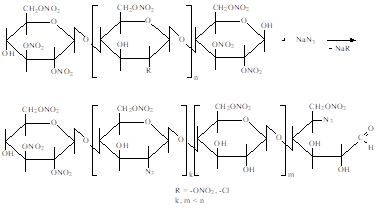SYNTHESIS OF AZIDOCELLULOSE NITRATES
UDC 661.728.86
Abstract
A synthesis method of azidocellulose nitrate by chemical interaction between cellulose nitrates or chlorocellulose nitrates with various degree of chlorination with sodium azide in a medium of dimethylsulfoxide and with heating in the temperature range 40–70 °C is proposed. The chemical composition, structure and properties of the obtained compounds are determined on the basis of combination of physico-chemical methods of analysis: IR, 1H NMR and 13C NMR spectroscopy; elemental analysis; gel permeation chromatography; viscometry; thermogravimetric analysis; differential scanning calorimetry; thermal polarization microscopy. The main directions of the chemical interaction between polymers and sodium azide were predicted by quantum-chemical methods using the Gaussian 09 software. The reaction mechanism was confirmed by a mathematical model of kinetics. The scheme of the preferred simultaneously going reaction directions has been composed, which includes substitution of nitrate groups by the azide fragment; rupture of polymer chains by β-glycosidic bond leading to depolymerization; opening of the glucopyranose cycle with addition of the azidogroup to the formed free bonds. Use of the chlorocellulose nitrate for the azidation allows to get products with a higher degree of substitution by azidogroups, and the rate of azidation of chlorocellulose nitrate depends on halogen content directly.
Downloads
Metrics
References
Rogovin Z.A., Shorygina N.N. Khimiya tsellyulozy i yeye sputnikov. [Chemistry of cellulose and its companions]. Mos-cow, 1953, 680 p. (in Russ.).
Panchenko O.A., Titova O.I. Khimiya rastitel'nogo syr'ya, 2005, no. 3, pp. 85‒88. (in Russ.).
Romanova S.M., Madyakina A.M., Sabirova D.I., Khuzeev M.V. Khimiya rastitel'nogo syr'ya, 2017, no. 2, pp. 19‒34. (in Russ.). DOI: 10.14258/jcprm.2017021562.
Urban P.G. Bretherick’s Handbook of Reactive Chemical Hazards, Elsever Ltd, 2017, p. 1192.
Chaykina Ye.A., Gal'braykh L.S., Rogovin Z.A. Vysokomolekulyarnyye soyedineniya. Ser. B, 1967, vol. 9, pp. 151‒155. (in Russ.).
Yermolenko V.N. Polucheniye slozhnykh efirov tsellyulozy s alifaticheskimi aminokislotami: avtoref. dis. ... kand. khim. nauk. [Obtaining esters of cellulose with aliphatic amino acids: author. dis. ... Cand. chem. sciences]. Barnaul, 2011, 18 p. (in Russ.).
Verhoeven M.L.P.M. Cellulose nitrate as a biocompatible support to immobilize proteins and ligands for hemoperfu-sion: proefshrift doctor a an de Technische Universiteit Eindhoven, Helmond, 1988, 135 p. DOI: 10.6100/IR291318.
Kaila E. Paper and Timber, 1958, no. 6, p. 339.
Scherer P.C., Feild J. Rayon Textile Monthly, 1941, vol. 22, pp. 605‒607.
Hayward J., Purves C.B. Canad. J. Chem., 1954, vol. 32, pp. 19–30.
Segall G.H., Purves C.B. Canad. J. Chem., 1952, vol. 30, pp. 860–871.
Patent 2157817 (RU). 2000. (in Russ.).
Patent 1656110A2 (EP). 2003.
Patent 2555903 (RU). 2003. (in Russ.).
Chapyshev S.V. Selektivnyye reaktsii azidnykh grupp, sintez i svoystva vysokospinovykh nitrenov: avtoref. diss. … dok. khim. nauk. [Selective reactions of azide groups, synthesis and properties of high-spin nitrenes: author. diss. ... doc. chem. sciences]. Moscow, 2004, 38 p. (in Russ.).
March J. Organicheskaya khimiya. Reaktsii, mekhanizmy i struktura. Uglublennyy kurs dlya universitetov i khimich-eskikh vuzov. [Organic chemistry. Reactions, mechanisms and structure. Advanced course for universities and chemistry universities]. Moscow, 1987, vol. 2, 504 p. (in Russ.).
Brase S., Gil C., Knepper K., Zimmerman V. Angew. Chem. Int. Ed., 2005, vol. 44, pp. 5188–5240. DOI: 10.1002/anie.200400657.
Dement'yeva D.I. Nitraty tsellyulozy: praktikum dlya studentov spetsial'nosti 251200 po kursu «Fizika i khimiya po-limerov. Tekhnologiya efirov tsellyulozy». [Cellulose nitrates: workshop for students of specialty 251200 on the course «Physics and chemistry of polymers. Cellulose Ether Technology»]. Biysk, 2001, 27 p. (in Russ.).

Copyright (c) 2020 chemistry of plant raw material

This work is licensed under a Creative Commons Attribution 4.0 International License.

This work is licensed under a Creative Commons Attribution 4.0 International License.
The authors, which are published in this journal, agree to the following conditions:
1. Authors retain the copyright to the work and transfer to the journal the right of the first publication along with the work, at the same time licensing it under the terms of the Creative Commons Attribution License, which allows others to distribute this work with the obligatory indication of the authorship of this work and a link to the original publication in this journal .
2. The authors retain the right to enter into separate, additional contractual agreements for the non-exclusive distribution of the version of the work published by this journal (for example, to place it in the university depository or to publish it in a book), with reference to the original publication in this journal.
3. Authors are allowed to post their work on the Internet (for example, in a university repository or on their personal website) before and during the review process of this journal, as this may lead to a productive discussion, as well as more links to this published work.











